Glasgow Corporation Tramways
Glasgow Corporation took over the Glasgow tram system from the Glasgow Tramway and Omnibus Company in 1894. It absorbed the tram systems of adjacent towns such as Paisley, Coatbridge and Clydebank. By 1922 there were 1000 trams and over 100 miles of track.
David Capper (Farebox 1969) reported that Glasgow initially used a fare system of ½d for 1 stage and 1d for 2 to 4 stages for adults.
A proposal to make the ½d fare valid for a 2 stage journey was defeated in 1910. This led to a ¾d 2 stage fare experiment being considered. In order to avoid the conductors having to deal with farthings, passengers had to pay 1½d for a token, which they retain and presented for another two stage journey on any part of the system - an early return ticket. This was was launched in January 1911. The result was that the number penny fares reduced but there was an increase in traffic and many passengers started buying two stage tokens instead of halfpenny tickets. The result was an increase in revenue. Consequently the two-stage fare, which was a temporary experiment, was retained.
In March 1911 Glasgow introduced free tokens for use by the blind. The conductors treated these as cash with ordinary car ticket being given to the blind passenger in exchange for the tokens. This system proved to be unsatisfactory and was replaced by photo ID travel passes in January 1912.
As was typical of municipal systems, the increase in costs in 1919 led to the tramway operation running at a loss. This led to the ½d fare for one stage being increased to 1d. As a compensation measure Glasgow Corporation made 2 stage tokens available for bulk discount sale. They were sold from tramway kiosks and at offices at 12 for 9d, a nominal value of ¾d. To facilitate this over a million tokens were produced in a wide variety of shades and die varieties. Over 750,000 were sold prior to the launch. The new fares came in to operation from June 1920. The 2 stage tokens were withdrawn in July 1926. People who had 2 stage tokens could have two of them exchanged for a penny and halfpenny token - tokens that, although not abolished, had been withdrawn from circulation.
Crdue Design
| Crude Design - Probably earliest produced 1894-1910 | ||
|---|---|---|
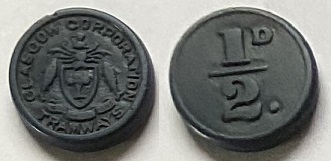
| ||
| Source | ||
| Filename | GLA.101 | |
| Value | ½d | |
| Add Desc. | Simple fish, wreath of 4 lines, crude bishop, crozier on bishop's right | |
| Size (mm) | 22 x 3 | |
| Manufacture | Dark Blue | |
| Notes | GLA.Crude Varieties | |
Vulcanised Fibre
The vulcanised fibre 2 Stage Tramway tokens have close die similarity to the large green 1/2d Transport tokens, which are made from celluloid. See GLA.Large 1/2d Transport Varieties. Even before the change of name to Glasgow Corporation Transport, Glasgow Corporation ran buses and took over the underground. The indication is that although these tokens say Transport, they pre-date the change of name.
| Vulcanised Fibre - Probably produced 1910-1920 | ||
|---|---|---|
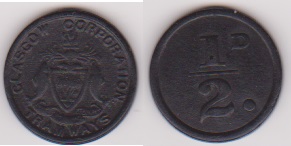
| ||
| Source | (Smith 420AK) | |
| Filename | GLA.0005f | |
| Value | ½d | |
| Add Desc. | ||
| Size (mm) | 22.75 x 2.5 | |
| Manufacture | Black Fibre | |
| Notes | GLA.Fibre1 Varieties | |

| ||
| Source | (Smith 420AN) | |
| Filename | GLA.0001f | |
| Value | 1d | |
| Add Desc. | ||
| Size (mm) | 22.25 x 2.75 | |
| Manufacture | Light Brown or Grey Fibre | |
| Notes | Example may have turned light brown from grey through age/use | |
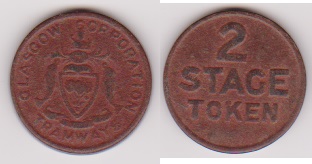
| ||
| Source | (Smith 420AU, 420AV) | |
| Filename | GLA.Z01d | |
| Value | 2 Stage | |
| Add Desc. | Bishop with tram driver's cap | |
| Size (mm) | 22.75 to 24.25, 2.5 thick | |
| Manufacture | Maroon Fibre | |
| Notes | GLA.Fibre2 Varieties | |

| ||
| Source | (Smith) | |
| Filename | GLA.2S001e | |
| Value | 2 Stage | |
| Add Desc. | Bishop to CO, pointed hat. TRAMWAYS wider than banner and offset left. Curved bird | |
| Size (mm) | 24 x 2.5 | |
| Manufacture | Maroon Fibre | |
| Notes | ||
Bakelite
| Bakelite - Design suggests experiment before fibre tokens. Probably about 1910 | ||
|---|---|---|

| ||
| Source | (Smith 420AJ) | |
| Filename | GLA.Z01fvii | |
| Value | 2 Stage | |
| Add Desc. | ||
| Size (mm) | 22.3 to 23.2, 3.5 thick | |
| Manufacture | Maroon Bakelite | |
| Notes | GLA.Bakelite Varieties | |
Type 1
The simple design and similarity of the arms wreath to the vulcanised fibre issue indicates that the type below followed on from the vulcanised fibre issue.
Type 2
The similarity of the arms wreath to the vulcanised fibre issue indicates that the type below followed on from the vulcanised fibre issue. The bishop is square in this type and looks like a bit like a garden gnome. This is the only early celluloid issue indicated with ½d and 1d denominations.
| Celluloid Type 2 - Probably produced 1910-1920 | ||
|---|---|---|

| ||
| Source | (Smith) | |
| Filename | GLA.3001.jpg | |
| Value | ½d | |
| Add Desc. | ||
| Size (mm) | 22.4 x 2.3 | |
| Manufacture | Dark Blue Celluloid | |
| Notes | ||

| ||
| Source | (Smith) | |
| Filename | GLA.0005d | |
| Value | ½d | |
| Add Desc. | ||
| Size (mm) | 21.8 to 22.3, 1.5 to 2.3 thick | |
| Manufacture | Light Turquoise to Dark Turquoise Celluloid | |
| Notes | GLA.Half3 Varieties | |

| ||
| Source | (Smith) | |
| Filename | GLA.001a | |
| Value | 1d | |
| Add Desc. | ||
| Size (mm) | 21.6 to 22.1, 2 to 2.5 thick | |
| Manufacture | White Celluloid | |
| Notes | GLA.One3 Varieties | |
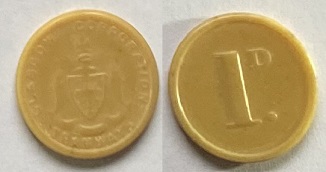
| ||
| Source | (Smith) | |
| Filename | GLA.30031 | |
| Value | 1d | |
| Add Desc. | ||
| Size (mm) | 21.6, 2.2 thick | |
| Manufacture | Translucent Light Yellow Celluloid | |
| Notes | Front is flat design, partially incuse. | Example may have turned light yellow from white through age/use |

| ||
| Source | (Smith) | |
| Filename | GLA.Z01fiv | |
| Value | 2 Stage | |
| Add Desc. | ||
| Size (mm) | 21.5 x 2.5 | |
| Manufacture | Maroon Celluloid | |
| Notes | GLA.2Stage3 Varieties | |
Type 3
The design and similarity of the arms wreath to the previous type indicates that the type below followed on from that type. The bishop is much thinner. There are varieties with the crozier on the bishop's right and the crozier on the bishop's left.
| Celluloid Type 3 - Probably about 1920 | ||
|---|---|---|

| ||
| Source | (Smith) | |
| Filename | GLA.Z01fv | |
| Value | 2 Stage | |
| Add Desc. | Crozier on bishop's right | |
| Size (mm) | 21.2 to 21.6, 2.3 to 2.6 thick | |
| Manufacture | Light Maroon to Dark Maroon Celluloid | |
| Notes | GLA.2Stage2a Varieties | |
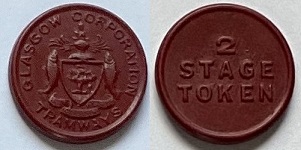
| ||
| Source | (Smith) | |
| Filename | GLA.2S042c | |
| Value | 2 Stage | |
| Add Desc. | Crozier to bishop's left | |
| Size (mm) | 21.3 to 21.7, 2.2 to 2.5 thick | |
| Manufacture | Light Maroon to Dark Maroon Celluloid | |
| Notes | GLA.2Stage2b Varieties | |
Type 4
For this type the design has substantial double wreath, one pointing up and one pointing down The bishop's crozier is on the bishop's left.
| Celluloid Type 4 - Probably about 1920 to 1925 | ||
|---|---|---|

| ||
| Source | (Smith) | |
| Filename | GLA.Z01b | |
| Value | 2 Stage | |
| Add Desc. | ||
| Size (mm) | 22 | |
| Manufacture | Black Plastic | |
| Notes | ||
| File:GLA.Z01c.jpg | ||
| Source | (Smith) | |
| Filename | GLA.Z01c | |
| Value | 0 | |
| Add Desc. | Two Stage | |
| Size (mm) | 22 | |
| Manufacture | Black Plastic | |
| Notes | holed | |
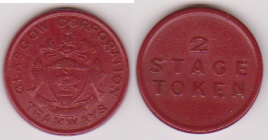
| ||
| Source | (Smith) | |
| Filename | GLA.Z01f | |
| Value | 2 Stage | |
| Add Desc. | ||
| Size (mm) | 21.4 to 22.1, 2.3 to 2.7 thick | |
| Manufacture | Light Maroon to Dark Maroon Celluloid | |
| Notes | GLA.2Stage3a Varieties | |
Type 5
The similarity of the bishop and arms wreath to the transport tokens first main issues indicates that the type was the last tramways type to be issued. The wreath is a single full wreath pointing up. This is the only other celluloid issue indicated with ½d and 1d denominations. They were probably produced in 1926 to facilitate the withdrawl of the 2 stage tokens.
| Celluloid Type 5 - Probably produced 1920-1926 | ||
|---|---|---|
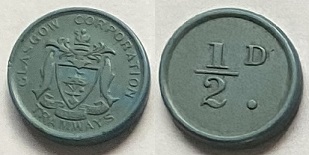
| ||
| Source | (Smith) | |
| Filename | GLA.5002c.jpg | |
| Value | ½d | |
| Add Desc. | Probably produced 1926 | |
| Size (mm) | 21.6 to 22.1, 2.2 to 2.5 thick | |
| Manufacture | Light Turquoise to Turquoise Celluloid | |
| Notes | GLA.Half5a Varieties | |
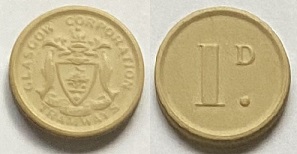
| ||
| Source | (Smith) | |
| Filename | GLA.5001b | |
| Value | 1d | |
| Add Desc. | Probably produced 1926 | |
| Size (mm) | 21.7 x 2.5 | |
| Manufacture | White Celluloid | |
| Notes | GLA.One5 Varieties | |

| ||
| Source | (Smith) | |
| Filename | GLA.Z01fvi.jpg | |
| Value | 2 Stage | |
| Add Desc. | ||
| Size (mm) | 21.5 x 2.5 | |
| Manufacture | Red Celluloid | |
| Notes | GLA.2Stage5a Varieties | |

| ||
| Source | (Smith) | |
| Filename | GLA.Z01fviii.jpg | |
| Value | 2 Stage | |
| Add Desc. | ||
| Size (mm) | 21.3 to 22.1, 2.2 to 2.6 thick | |
| Manufacture | Light Maroon to Dark Maroon Celluloid | |
| Notes | GLA.2Stage5b Varieties | |
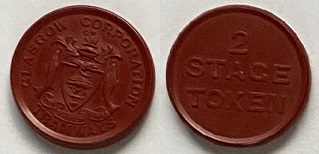
| ||
| Source | (Smith) | |
| Filename | GLA.502SF.jpg | |
| Value | 2 Stage | |
| Add Desc. | Fine detail. | |
| Size (mm) | 21.7 to 22.1, 2.2 to 2.5 thick | |
| Manufacture | Light Maroon Celluloid | |
| Notes | GLA.2Stage5c Varieties | |
Comparison of Types
| Glasgow Corporation Tramways 2 Stage - Comparison of Types | ||
|---|---|---|

| ||
| Source | (Smith) | |
| Filename | GLA.Z01f | |
| Value | 0 | |
| Add Desc. | Two Stage | |
| Size (mm) | 21.5 to 24.25, 1.5 to 3.5 Thick | |
| Manufacture | Various - Red/Maroon | |
| Notes | GLA.Z01f Varieties | |
| Glasgow Corporation Tramways - Type to be confirmed | ||
|---|---|---|
| File:GLA.0005a.jpg | ||
| Source | (Smith) | |
| Filename | GLA.0005a | |
| Value | ½d | |
| Add Desc. | ||
| Size (mm) | 23 | |
| Manufacture | White Plastic | |
| Notes | 1894-1929 | |
| File:GLA.0005b.jpg | ||
| Source | (Smith) | |
| Filename | GLA.0005b | |
| Value | ½d | |
| Add Desc. | ||
| Size (mm) | 23 | |
| Manufacture | Dark Red Plastic | |
| Notes | ||
| File:GLA.001c.jpg | ||
| Source | (Smith) | |
| Filename | GLA.001c | |
| Value | 1d | |
| Add Desc. | ||
| Size (mm) | 22 | |
| Manufacture | Dark Blue Plastic | |
| Notes | ||
| File:GLA.Z01a.jpg | ||
| Source | (Smith) | |
| Filename | GLA.Z01a | |
| Value | 0 | |
| Add Desc. | Two Stage | |
| Size (mm) | 22 | |
| Manufacture | Lemon Plastic | |
| Notes | ||


